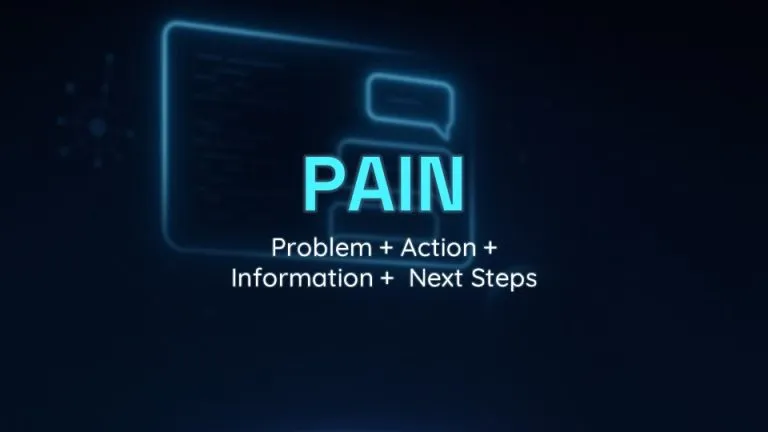PAIN Framework: Problem, Action, Information, Next Steps

Solving problems with the help of artificial intelligence can be simpler than it seems — especially with the PAIN framework. This structure was designed to turn challenges into practical solutions, guiding the AI to understand what’s wrong and how to act.
Composed of four elements — Problem, Action, Information, and Next Steps — PAIN is perfect for identifying a difficulty, finding useful answers, and planning what to do next, all in LLMs like ChatGPT, Grok, or Gemini.
Whether you’re an entrepreneur facing a business obstacle, a student seeking clarity, or someone trying to organize ideas, this framework offers a clear and actionable path. Let’s see how it works and how it can help you.
What is the PAIN Framework?
The PAIN framework is a practical approach focused on problem-solving in a structured way. Its four components help the AI understand the situation, take action, and provide a plan to move forward — making your prompts more objective and effective. Check out each part:
Structure Components
- Problem: Describes the challenge or issue you’re facing, like “my sales dropped” or “I can’t focus.”
- Action: Defines what you want the AI to do to help, such as “suggest solutions” or “create a method.”
- Information: Requests details or insights to clarify the problem, like “what are the causes?” or “what should I consider?”
- Next Steps: Asks for a plan or specific actions to resolve the issue, like “give a step-by-step guide” or “list priorities.”
These elements create a focused prompt that not only addresses the problem but also delivers a clear path to solve it.
When to Use It?
PAIN is perfect when you’re facing an obstacle and need practical help. Use it if:
- You want to identify and resolve a specific issue.
- You need ideas or strategies with clear steps to follow.
- You’re looking for a logical approach to overcome challenges.
💡 Use PAIN when you want to turn a problem into a concrete solution with ready-to-apply guidance.
I’m facing [Problem], and I need you to [Action]. Consider [Information]. The goal is to receive [Next Steps].
Practical Examples of PAIN in Action
To show how PAIN works, here are three examples applying the framework to real-life situations. See how it organizes prompts to generate useful, practical responses.
Example 1: Low Participation in Company Events
Context: You organize internal events at the company, but employees rarely attend.
I’m facing low employee participation in corporate events (Problem), so suggest ways to increase engagement (Action). Explain why people might be disinterested (Information) and provide a 3-step plan to boost attendance (Next Steps).Why it works: The Problem is clear, the Action asks for solutions, the Information seeks causes, and the Next Steps deliver an actionable plan.
Example 2: Difficulty Learning a New Language
Context: You’re trying to learn Italian but feel you’re not making progress.
I’m struggling to make progress learning Italian (Problem), so create a method to improve my practice (Action). Detail what common barriers might be holding me back (Information) and suggest 4 practical steps to follow over the next 30 days (Next Steps).Why it works: The Problem defines the obstacle, the Action asks for help, the Information clarifies the context, and the Next Steps offer a roadmap.
Example 3: Lack of Blog Content Ideas
Context: You run a gardening blog but are out of inspiration for new posts.
I’m out of ideas for posts on my gardening blog (Problem), so generate creative suggestions for new content (Action). Explain what might be blocking my creativity (Information) and list 3 actions to maintain a steady flow of ideas (Next Steps).Why it works: The Problem highlights the issue, the Action requests ideas, the Information explores causes, and the Next Steps create a sustainable plan.
Tips to Make the Most of PAIN
PAIN is straightforward and efficient, but customizing it can make it even more powerful. Adjusting each component to your specific case ensures more aligned solutions. Here’s how:
Customize for Your Goal
Adapt the PAIN elements to reflect your challenge and needs:
- Problem: Describe the obstacle in detail. “I don’t sell enough” is generic; “sales dropped 20% over 3 months” is specific.
- Action: Choose an action that solves the issue. “Help me” is vague; “suggest 3 strategies” is clear.
- Information: Ask for useful insights. “What’s wrong?” is broad; “which factors affect this?” focuses the analysis.
- Next Steps: Define realistic steps. “Fix everything” is abstract; “list 3 tasks for this week” is practical.
Quick example: “My team doesn’t collaborate well on projects (Problem), so suggest ways to improve cooperation (Action). Explain possible reasons for the lack of synergy (Information) and give 3 steps to implement this week (Next Steps).”
These adjustments make PAIN a tailor-made tool for tackling any difficulty with confidence.
Start Using PAIN Today
With the PAIN – Problem, Action, Information, Next Steps framework, you have a simple and powerful structure to turn challenges into practical solutions. Whether to overcome blocks, find answers, or plan actions, it guides the AI to deliver results you can apply immediately — saving you time and effort.
🎯 Quick summary:
PAIN identifies what’s wrong (Problem), defines what to do (Action), brings helpful insights (Information), and plans what’s next (Next Steps).
🔗 Want to explore more frameworks like this?
Check out the Practical Guide to Prompt Techniques, Frameworks, and Formulas for LLMs, with dozens of detailed and applicable structures for different contexts and goals, plus techniques and prompt engineering tips.
📘 Bonus tip:
Download the free eBook “Prompt Engineering Unveiled”, featuring easy explanations, practical examples, and strategies ranging from basic to advanced to master communication with AI.



